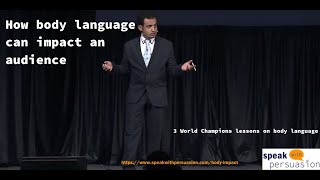The Importance Of Body Language In Public Speaking
Picture this: you’re standing in front of a crowd, ready to deliver a speech. As you begin, words flow from your mouth with confidence and conviction. But did you know that it’s not just your words that are speaking volumes? Your body language, the way you hold yourself, move, and gesture, is silently conveying a wealth of information to your audience. That’s the importance of body language in public speaking.
When we think of communication, we often focus on what we say. But studies show that a staggering 55% of communication is actually conveyed through body language. Our facial expressions, hand movements, posture, and even eye contact can greatly impact how our message is received. So, if you want to become a powerful and persuasive public speaker, mastering your body language is key.
Effective body language can enhance your speech in numerous ways. It helps you connect with your audience on a deeper level, build trust and credibility, and convey confidence and authority. By using open and expansive gestures, maintaining good eye contact, and adopting an upright posture, you signal to your audience that you are confident in your message and believe in what you’re saying. This nonverbal communication helps captivate your listeners and keeps them engaged throughout your presentation.
So, whether you’re talking to a small group or addressing a large crowd, understanding and utilizing the power of body language is essential for effective public speaking. By aligning your words with your nonverbal cues, you can create a powerful and compelling message that resonates with your audience. In the following paragraphs, we’ll explore the different aspects of body language and how you can harness its power to become a more effective and impactful public speaker. Are you ready to take your speaking skills to the next level? Let’s dive in!

The Importance of Body Language in Public Speaking: Unlocking the Power of Non-Verbal Communication
Public speaking is not just about what you say, but how you say it. In fact, studies have shown that body language plays a crucial role in effective communication, often even more so than the words we choose. Whether you’re presenting at a conference, giving a TED talk, or delivering a speech at a wedding, understanding and utilizing the power of body language can greatly enhance your impact and connection with the audience. In this article, we will explore the various aspects of body language in public speaking and how you can leverage them to become a more confident and influential speaker.
Mastering the Art of Eye Contact: Establishing Trust and Connection
Making eye contact is one of the most fundamental and powerful aspects of body language in public speaking. When you look directly into someone’s eyes, it creates a genuine connection and establishes trust. Eye contact also communicates confidence and indicates that you value your audience’s presence and participation. However, maintaining eye contact can be challenging, especially if you’re nervous or speaking to a large crowd. Here are a few tips to help you master the art of eye contact:
1. Scan the room: Take a few moments before your speech to scan the room and make eye contact with different individuals in the audience. This will help you establish a connection right from the start.
2. Use the Triangle Technique: Divide the audience into three sections – left, center, and right. Rotate your eye contact between these sections, focusing on individuals for a few seconds before moving on to someone else. This ensures that everyone feels seen and engaged.
3. Pause and Connect: Whenever you make a particularly important or impactful statement, pause for a moment and lock eyes with someone in the audience. This not only reinforces your message but also creates a more personal connection with your listeners.
Remember, maintaining eye contact may feel uncomfortable initially, but with practice, it will become second nature and greatly enhance your public speaking skills.
The Power of Posture: Conveying Confidence and Authority
Your posture speaks volumes about your confidence and authority as a speaker. How you carry yourself on stage can influence how your message is received by the audience. Here are some key points to keep in mind when it comes to posture in public speaking:
1. Stand Tall: Stand up straight with your shoulders back and your head held high. This posture not only conveys confidence but also allows for proper airflow, enabling you to project your voice more effectively.
2. Occupy Space: Take up space on the stage. Avoid crossing your arms or clutching onto the podium. Instead, use hand gestures to emphasize key points and move around the stage, taking advantage of the entire space.
3. Use Mirroring: Mirroring is a powerful technique that involves subtly mimicking the body language of your audience. This can help build rapport and make your listeners feel more connected to you. However, be mindful not to overdo it, as it should be done subtly and naturally.
By paying attention to your posture, you can present yourself as a confident and authoritative speaker, which will captivate your audience and command their attention.
The Impact of Gestures: Enhancing Communication and Body Language
Gestures are another essential component of body language that can greatly enhance your communication and engagement with the audience. Here are some ways you can effectively utilize gestures in your public speaking:
1. Use Open Palm Gestures: Open palm gestures are seen as more welcoming and trustworthy. Instead of pointing or making closed-fist gestures, opt for open palms to convey openness and inclusion.
2. Emphasize with Purpose: Use gestures to emphasize key points in your speech. For example, you can use your hands to illustrate the size of something or create visual imagery that complements your words. Just be sure that your gestures are intentional and aligned with your message.
3. Be Mindful of Nervous Habits: Nervous habits like fidgeting, tapping your foot, or playing with your hair can be distracting to your audience and undermine your credibility. Be aware of these habits and work on minimizing or eliminating them through practice and self-awareness.
Incorporating purposeful and mindful gestures into your public speaking can not only make your delivery more engaging but also help to reinforce your message and capture your audience’s attention. Practice in front of a mirror or record yourself to identify areas for improvement and ensure your gestures are in alignment with your message.
The Role of Facial Expressions: Conveying Emotion and Authenticity
Facial expressions are a critical component of body language in public speaking, as they can convey emotion, enhance your authenticity, and capture the attention of your audience. Here are some tips for utilizing facial expressions effectively:
1. Smile: A genuine smile can instantly create a positive and welcoming atmosphere. Smiling also helps to establish rapport and make your audience feel more at ease.
2. Show Passion: Let your face reflect your passion and enthusiasm for your topic. Use your eyebrows, eyes, and mouth to demonstrate interest, excitement, or concern, depending on the nature of your speech.
3. Be Authentic: Allow your facial expressions to be natural and in line with how you genuinely feel. Authenticity is key to building trust and connecting with your audience on a deeper level.
Remember that facial expressions can be contagious, so by showing genuine emotion, you can create an emotional connection with your listeners and make your message more impactful.
The Impact of Vocal Delivery: Tone, Pitch, and Pauses
While body language primarily refers to non-verbal communication, vocal delivery is an integral part of public speaking and greatly influences how your message is received by the audience. Here are some key aspects of vocal delivery to consider:
1. Tone: Pay attention to the tone of your voice. Varying your tone can help convey different emotions and add depth to your message. Speak with warmth, authority, or urgency, depending on what is appropriate for your topic.
2. Pitch: Explore the range of your voice and utilize both high and low pitches to add variety and captivate your audience’s attention. However, be mindful of an excessively high or low pitch, as it can come across as unnatural or annoying.
3. Pauses: Effective use of pauses can create emphasis, allow your audience to process information, and build anticipation. Use strategic pauses before or after important points to make them stand out and give your listeners time to absorb the information.
By paying attention to your vocal delivery, you can amplify the impact of your message and keep your audience engaged throughout your speech.
The Role of Proxemics: Using Space to Connect with Your Audience
Proxemics refers to the study of how people use space to communicate and interact with one another. By understanding the principles of proxemics, you can use space effectively to connect with your audience and enhance your public speaking. Here are a few ways you can leverage proxemics:
1. Stand at the Edge: Rather than staying glued to the center of the stage, try standing at the edge closest to the audience. This will create a sense of intimacy and allow you to establish a stronger connection.
2. Move Purposefully: Use purposeful movement to engage your audience and create a dynamic atmosphere. Walking towards an individual or a specific area can draw attention and emphasize key points.
3. Respect Personal Space: Be mindful of personal space and audience comfort. If you move too close to someone, it may make them feel uncomfortable. Give individuals room to breathe and maintain a respectful distance.
By using space intentionally and respectfully, you can create a more immersive and engaging experience for your audience, amplifying the impact of your public speaking.
Finding Your Authentic Self: Balancing Body Language and Personal Style
When it comes to body language in public speaking, it’s crucial to strike a balance between following best practices and staying true to your authentic self. While incorporating effective body language techniques can enhance your communication, it’s essential to adapt them to your personal style and comfort level. Ultimately, your body language should align with your personality and the message you want to convey. Experiment, practice, and find what works best for you. Embrace your unique style while leveraging the power of body language to become a more confident, influential, and impactful speaker.
Remember, mastering body language in public speaking takes time and practice. Start by implementing one or two techniques at a time and gradually incorporate more as you become comfortable. By investing in your non-verbal communication skills, you can elevate your public speaking to new heights, connect with your audience on a deeper level, and leave a lasting impression. So, take the stage, own your body language, and let your words speak through your actions.
The Importance of Body Language in Public Speaking
- Body language can greatly enhance your public speaking skills and help you connect with your audience.
- Using open and confident gestures can convey authority and credibility.
- Eye contact shows engagement and builds trust with your audience.
- Good posture makes you appear more confident and professional.
- Using facial expressions effectively can help convey emotions and enhance your message.
Frequently Asked Questions
In public speaking, body language plays a crucial role in effectively conveying your message and connecting with your audience. It helps you establish credibility, engage your listeners, and enhance the overall impact of your speech. Here are some key questions and answers about the importance of body language in public speaking.
1. How does body language impact public speaking?
Body language is a powerful form of nonverbal communication that can greatly influence how your message is perceived by the audience. It includes your facial expressions, gestures, posture, and eye contact. By using appropriate body language, you can convey confidence, enthusiasm, and sincerity, which are key elements in engaging and persuading your audience. Poor body language, on the other hand, can make you appear nervous, untrustworthy, or disinterested, leading to a diminished impact on your listeners.
Moreover, body language can help enhance your verbal message by emphasizing key points, adding visual interest, and reinforcing the emotions you want to convey. It can also help establish a connection with your audience, making them more receptive to your ideas and boosting their engagement throughout your speech.
2. How can eye contact improve public speaking?
Eye contact is a fundamental aspect of effective public speaking. When you maintain eye contact with your audience, it shows that you are present and focused on them. It creates a sense of connection and trust, making your listeners feel valued and involved in the conversation. Eye contact also helps you gauge the audience’s reaction, allowing you to adjust your delivery accordingly and maintain their attention.
Furthermore, eye contact helps establish rapport with the audience. When you look directly at individuals in the crowd, it gives the impression that you are speaking to each person individually, fostering a stronger connection and engagement. By making intentional eye contact, you can effectively establish your credibility, build trust, and have a more impactful presentation.
3. What role does posture play in public speaking?
Your posture during a public speaking engagement can greatly influence how your audience perceives you. When you stand tall with an open posture, it conveys confidence, authority, and approachability. This can instantly captivate your listeners and make them more receptive to your message. Conversely, slouching or maintaining a closed-off posture can make you appear insecure, unprofessional, or disinterested, diminishing your credibility and the impact of your speech.
In addition to the impression it creates, posture also affects your own state of mind during public speaking. Standing up straight and maintaining a confident posture can help boost your own confidence and reduce nervousness. Proper posture enables better breathing and vocal projection, allowing you to deliver your message with clarity and conviction.
4. How important are facial expressions in public speaking?
Facial expressions are a vital component of body language that can significantly contribute to the effectiveness of your public speaking. Your face is capable of conveying a wide range of emotions, and leveraging this tool can help you engage your audience on a deeper level. Expressions such as smiles, raised eyebrows, or frowns can immediately communicate enthusiasm, empathy, concern, or seriousness, depending on the context of your speech.
Using appropriate and authentic facial expressions can help you establish a rapport with your audience and convey your message with greater impact. When your facial expressions align with the emotions and content of your speech, it enhances your credibility, and helps your listeners connect with your message on an emotional level. It also helps keep your audience engaged and attentive throughout your presentation.
5. What gestures are effective in public speaking?
Gestures are physical movements of the arms, hands, and body that can add emphasis and visual interest to your public speaking. They can help illustrate your points, demonstrate concepts, and make your message more memorable. Effective gestures are intentional, purposeful, and aligned with the content and emotions you want to convey.
Some commonly used gestures in public speaking include open palms to convey sincerity and openness, pointing to emphasize specific details, and using hand movements to illustrate size, shape, or direction. However, it’s important to use gestures sparingly, ensuring they enhance your message rather than distract from it. Avoid overly repetitive or exaggerated gestures, as they can come across as artificial or distracting to your audience.

Summary
So, what did we learn about body language in public speaking? First, our body language says a lot about us, even when we’re not speaking. Second, our gestures, posture, and facial expressions can help us communicate effectively.
Remember, standing tall and making eye contact can boost your confidence and connect you with your audience. Lastly, don’t forget the power of a smile and using your hands to emphasize important points. So, next time you’re up in front of a crowd, pay attention to your body language and make a lasting impression!


